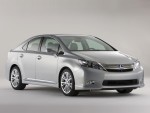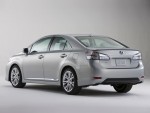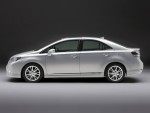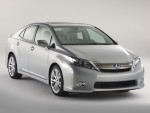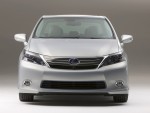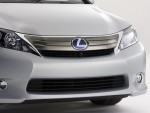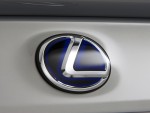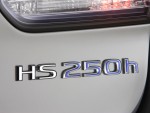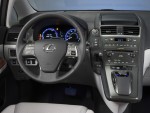2010 Lexus HS 250h
2010 Lexus HS 250h Pictures & Specifications
Home »
Lexus
Pictures & Wallpapers
Technical Specifications
Make: Lexus
Model: HS 250h
Engine: 2.4 litre four-cylinder electric hybrid
Aspiration: Natural
Maximum Power: –
Maximum Torque: –
Hybrid System Combined Maximum Power: 138 kW (approximate)
Transmission: –
Drivetrain: Front-wheel drive
Lexus Debuts World’s First Dedicated Luxury Hybrid
Lexus Press Release
13 January 2009
Lexus yesterday revealed the HS 250h, the world’s first dedicated luxury hybrid vehicle, at the North American International Auto Show.
The HS 250h will be the fourth hybrid for Lexus and the most fuel-efficient vehicle in its line-up.
It also will be the first Lexus to utilise carbon-neutral Ecological Plastic materials in a new futuristic cockpit, and interior design scheme.
A welcomed addition to the brand’s entry level luxury sedan line-up, the HS 250h fits between the IS luxury sport sedan and the ES luxury sedan.
Research has shown that more than 60 per cent of entry level luxury car buyers would have considered a hybrid if available, and the HS will provide these consumers with a viable purchase option.
Equipped with the first Lexus four-cylinder petrol engine, the 2.4-litre Atkinson-cycle powerplant is part of the latest Lexus Hybrid Drive System that generates approximately 138 kW across the total system.
The highly efficient Atkinson-cycle engine was made possible by using the Variable Valve Timing with intelligence (VVT-i) system, and it allows the expansion/power stroke to be longer than the compression stroke so that combustion energy can be more effectively used for production of engine power.
HS 250h’s expected fuel efficiency will be more than 30 per cent better than the most fuel-efficient model currently in the Lexus line-up, while earning a Super Ultra Low Emissions Vehicle (SULEV) emissions rating utilising regular petrol.
Among the technologies adopted in the 2.4-litre four-cylinder engine are piston oil jets for cooling; an optimised balance shaft rate for reduced Noise, Vibration and Harshness (NVH) characteristics; and a hot-air venting system mounted behind the radiator.
Like the all-new RX 450h hybrid utility vehicle that made its debut in November, the HS 250h will include a new system designed to improve efficiency. The exhaust heat recovery system reduces engine warm-up time, thus allowing it to stop earlier, more often, and for longer periods.
A windscreen with infrared-ray (IR) reduction properties, which helps keep the interior cooler, has been adopted in order to decrease the amount of air-conditioning needed to lower the cabin temperature.
In addition to the exhaust heat recovery system and the IR windscreen, available power-saving LED headlamps also contribute to improved fuel efficiency and emissions.
The all-new HS 250h sedan’s 0.27 drag co-efficient (Cd) makes it among the most aerodynamic in its class. Airflow management over the exterior, below the under-floor area and through the air passages was extensively examined.
A unique gull-wing-shaped roof-panel design reduces mass and overall vehicle height, thus reducing drag and improving fuel efficiency. The front spoiler, rear spoiler, rear under spoiler, and diffuser fins all reduce turbulence.
Smooth A-pillar shape and the optimised angle and curvature of the bumper side panels also reduce wake turbulence, as does the increased taper of the fender side panels.
The under-floor covers have been optimally positioned for reduced drag, while airflow restriction in the engine compartment has been lowered by optimising the air-duct profiles around the radiator.
Aerodynamic design has also contributed to decreased wind noise. A smoother transition between windscreen (complete with a sound-insulating inner layer) and roof line has improved air flow and reduced turbulence.
As is appropriate for the first dedicated luxury hybrid vehicle, the HS 250h includes proactive adoption of plant-based, carbon-neutral “Ecological Plastics” or bio-plastics in specific interior areas.
Ecological Plastic emits less carbon dioxide during a product’s lifecycle than plastic made solely from petroleum.
Among the areas of utilisation will be an industry-first use in luggage-trim upholstery. Other areas are the cowl-side trim, door scuff plate, tool box area, floor-finish plate, seat cushions, and the parcel shelf behind the rear seats.
Overall, approximately 30 per cent of the interior and luggage area is covered with Ecological Plastic. Over the estimated lifecycle of the vehicle, the HS 250h will have approximately 20 per cent fewer carbon-dioxide emissions as a result of the Ecological Plastic trim pieces.
Like all Lexus hybrid models, significant time was spent in developing the HS 250h with optimised NVH characteristics. Dynamic dampers at each engine-mounting point reduce noise and vibration, resonators improve intake air noise, and optimised exhaust flow reduces exhaust sound.
Special coatings dampen both engine and road noise, while improved seals around doors, hood and fenders reduce wind-noise penetration into the cabin.
Vibration has been reduced by improving the shape and thickness of the suspension-mounting points.
In addition, power-window speed controllers have been adopted from the LS luxury sedan, which ensure a slower, soft closing rate.
The HS 250h chassis design provides outstanding ride and comfort with the decreased NVH required by a Lexus hybrid. The MacPherson strut front suspension is designed to achieve both straight-line and braking control, and a positive steering feel.
A double-wishbone rear suspension provides excellent manoeuvrability, control and comfort with a low spring mount that contributes to better packaging and superior cargo space. Coil springs, anti-roll bars and shock-absorber rebound springs are used front and rear. The HS 250h will have uniquely designed standard 17- and optional 18-inch wheels.
The rack-and-pinion steering system utilises a brushless Electric Power Steering (EPS) motor on the steering column, which provides improved steering feel, a reduction in harsh feedback, and better emissions by not draining engine power like conventional hydraulic systems.
The EPS is an integral part of an available lane keep assist system, a new driver assist that adds smooth steering torque to help the vehicle stay in the centre of the lane.
The amount of assisted torque is dependant on a lane-marker detection camera. It includes a lane departure warning feature that is designed to detect possible lane departure; it then gives the driver an audible warning and provides feedback via the steering wheel to encourage corrective action.
The HS is slightly longer than the IS and is taller than both the IS and ES. It also has a greater couple distance (distance hip to hip between front and rear passengers) than any other vehicle in its class other than the ES. The contoured front-seat backs also add to increased rear-seat legroom.
The HS features a unique advanced cockpit and an interior design that emphasises innovation and craftsmanship. The uniquely stylish cabin has standard leather-trim seats, a moonroof, Lexus premium audio systems, and a new standard multi-media package.
The media features include Bluetooth technology, integrated satellite radio (subscription required), voice recognition, and USB iPod connectivity controlled via steering-wheel controls or a display screen.
A high-contrast multi-information display, located in the instrument panel’s hybrid system indicator gauge, is controlled via steering-wheel-mounted controls, allowing the driver to easily control various functions and information.
Lexus’ new available Hard Disk Drive (HDD) Navigation System features an all-new “Remote Touch” controller that is both intuitive and ergonomic.
Similar to the system in the new RX, the controller is positioned on the centre console and is as natural to the driver’s hand as a computer mouse. It can also be customized to the desired level of haptic feedback. The retractable navigation screen is positioned well back in the front dash to help improve visibility and reduce driver eye movement.
The Navigation System also includes a new casual-speech voice recognition feature. This allows drivers to give more flexible, conversational commands for easier access and control of the audio, climate and navigation functions.
Also included are XM NavTraffic and NavWeatherTM, along with XM Sports and stock information.
Also helping to reduce driver eye movement is an optional Head-Up Display (HUD). The HUD uses high-intensity LEDs to make the display bright enough to be read even in direct sunlight.
A class-leading 10 airbags will be standard on the all-new HS 250h as well as active front head rests, which help passengers in case of certain types of rear-end accidents.
The HS also will feature Vehicle Stability Control (VSC) and optional Pre-Collision System with Dynamic Radar Cruise Control.
An available wide-view front monitor helps the driver to check hard-to-see areas. Using a camera mounted in the front grille, the monitor provides a 190-degree front view on the Navigation screen with the push of a button on the steering wheel.
The HS 250h will also offer Lexus’ next generation telematics systems, Lexus Enform and Safety Connect. Safety Connect will provide automatic collision notification, stolen vehicle location, 24/7 emergency and roadside assistance.
Lexus Enform’s Destination Assist features operators who will help drivers look up points of interest such as shopping centres or other business locations, and then wirelessly send directions directly to the vehicle’s navigation system.
Lexus Enform’s eDestination service will allow customers to pull up multiple points of interest on any computer and send them directly to the car’s navigation system. This innovative new feature will allow drivers to send a total of 200 destinations at a time to their vehicles.
The all-new 2010 HS 250h will reach U.S. dealerships nationwide late in the northern hemisphere summer.
